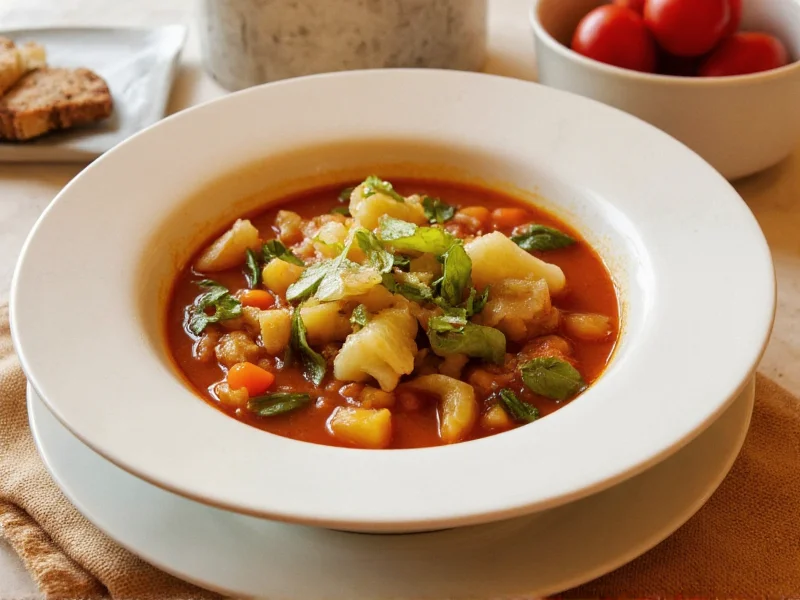The Nutritional Powerhouse in Your Pot
Cabbage takes center stage in this humble soup for excellent reasons. One cup of cooked cabbage provides over 70% of your daily vitamin C needs and significant vitamin K, crucial for blood health and bone density. When combined with carrots, celery, onions, and garlic in a vegetable broth base, you create a symphony of nutrients that work together synergistically.
Unlike the restrictive cabbage soup diet fad, a well-balanced cabbage veggie soup offers sustained nutrition. The fiber content (approximately 4 grams per serving) promotes satiety without deprivation, making it an excellent component of a healthy eating pattern. The sulfur compounds in cabbage support liver detoxification pathways, while the carotenoids from carrots and tomatoes provide antioxidant protection.
Essential Ingredients for Flavorful Cabbage Soup
Creating the best cabbage vegetable soup requires attention to ingredient quality and preparation. Here's what you need for a foundational recipe serving 6:
| Ingredient | Quantity | Preparation Notes |
|---|---|---|
| Green cabbage | 1 medium head (about 2 lbs) | Thinly sliced, core removed |
| Carrots | 3 medium | Diced small for even cooking |
| Celery | 3 stalks | Finely chopped including leaves |
| Yellow onion | 1 large | Diced |
| Garlic | 4 cloves | Minced |
| Vegetable broth | 6 cups | Low-sodium preferred |
| Canned tomatoes | 1 (14.5 oz) can | Diced, no salt added |
| Olive oil | 2 tablespoons | For sautéing |
| Dried thyme | 1 teaspoon | Fresh works too |
| Bay leaves | 2 | Remove before serving |
Step-by-Step Cooking Instructions
Follow these professional techniques for the most flavorful cabbage soup experience:
- Sauté aromatics: Heat olive oil over medium heat. Add onions, carrots, and celery. Cook for 8-10 minutes until softened but not browned.
- Add garlic and spices: Stir in minced garlic, thyme, and a pinch of red pepper flakes. Cook for 1 minute until fragrant.
- Incorporate cabbage: Add sliced cabbage and cook for 5 minutes, stirring occasionally, until slightly wilted.
- Build the broth: Pour in vegetable broth and diced tomatoes with their juice. Add bay leaves.
- Simmer to perfection: Bring to a boil, then reduce heat to low. Cover and simmer for 25-30 minutes until vegetables are tender but still retain texture.
- Final seasoning: Remove bay leaves. Stir in 2 tablespoons lemon juice or apple cider vinegar to brighten flavors. Adjust salt and pepper to taste.
Delicious Variations for Every Diet
Customize your cabbage soup to match your dietary preferences without sacrificing flavor:
- Protein boost: Add 1 cup white beans or lentils during the last 15 minutes of cooking for extra protein and fiber
- Mediterranean twist: Stir in 1/2 cup chopped fresh dill and 1 tablespoon lemon zest before serving
- Spicy version: Add 1 diced jalapeño with the aromatics and 1/2 teaspoon smoked paprika
- Creamy adaptation: Blend 2 cups of soup and return to pot with 1/2 cup coconut milk for richness
- Winter warmer: Add 1 cup diced sweet potato with the broth for seasonal variation
Storage and Reheating Best Practices
Cabbage veggie soup excels as meal prep. Follow these storage guidelines for maximum freshness:
- Cool completely before storing (within 2 hours of cooking)
- Store in airtight containers for up to 5 days in the refrigerator
- Freeze in portion-sized containers for up to 3 months
- Reheat gently on the stove over medium-low heat
- Add a splash of broth or water when reheating to restore consistency
- Enhance reheated soup with fresh herbs or a squeeze of lemon
Unlike many soups, cabbage soup actually improves in flavor after 24 hours as the ingredients meld together. The cabbage texture becomes more tender while maintaining structure when stored properly.
Common Mistakes to Avoid
Even simple recipes can go wrong. Steer clear of these cabbage soup pitfalls:
- Overcooking the cabbage: Adding it too early results in mushy texture. Wait until aromatics are softened before adding.
- Skipping the acid component: Lemon juice or vinegar at the end brightens flavors and balances the earthiness.
- Using poor quality broth: The broth forms the soup's foundation—choose low-sodium varieties you'd enjoy drinking plain.
- Insufficient seasoning: Cabbage needs proper salt to shine. Season in layers throughout cooking.
- Adding frozen vegetables: They release too much water and become mushy. Stick with fresh for best texture.
Why This Soup Belongs in Your Regular Rotation
Beyond its impressive nutrient profile, cabbage veggie soup offers practical advantages for modern living. It's an ideal solution for using up vegetables that might otherwise go to waste, reducing food costs while minimizing waste. The recipe scales effortlessly for batch cooking, making it perfect for weekly meal preparation.
Unlike restrictive cabbage soup diets that promise quick weight loss, this balanced approach delivers sustainable nutrition without deprivation. The combination of fiber, water content, and diverse nutrients creates a satisfying meal that supports healthy eating patterns long-term. Whether you're recovering from illness, looking for a light lunch option, or wanting to increase your vegetable intake, this versatile soup adapts to your needs.











 浙公网安备
33010002000092号
浙公网安备
33010002000092号 浙B2-20120091-4
浙B2-20120091-4